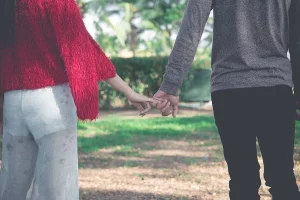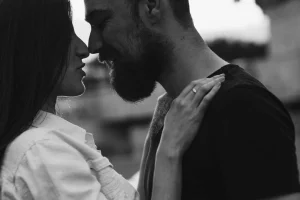Signs he likes you but is afraid of getting hurt include subtle glances that linger a moment too long, a guarded smile that conceals vulnerability, and a hesitancy in his words that speaks volumes about the walls he’s built around his heart.
In the intricate dance of human emotions, deciphering whether someone likes you can feel like navigating a maze of subtleties and unspoken cues. Yet, what if the object of your affection is caught in the delicate balance of attraction and apprehension, sending signals that scream interest but whisper caution?
Welcome to the enigmatic realm of “Signs He Likes But Is Afraid Of Getting Hurt,” where the subtle symphony of affection meets the muted notes of vulnerability.
Like a rare and elusive species, these signs are the delicate footprints of a heart tiptoeing on the edge of connection, leaving you to unravel the mystery of emotions entwined with the fear of potential heartache.
Buckle up for a journey through the labyrinth of love, where signals are both a beacon and a barricade, revealing a story of attraction laced with the cautionary whispers of a hesitant heart.

Signs He Likes You But Is Afraid Of Getting Hurt
Mixed Signals: The Delicate Balancing Act
In the realm of romantic emotions, men often send mixed signals when they’re intrigued yet cautious.
Expressions of interest may be tempered with a hesitancy to fully disclose emotions, creating a delicate balancing act between attraction and self-preservation Guarded Actions: Protecting the Heart
Actions speak louder than words, and when a man is afraid of getting hurt, he may exhibit guarded behaviors. He might initiate contact but pull back when emotions intensify.
These conflicting actions, often accompanied by evasive responses, can leave you wondering about his true feelings.
Communication patterns play a pivotal role in deciphering emotional hesitancy. A man who likes you but fears emotional vulnerability may display inconsistent communication.
He might engage deeply one day and withdraw the next, creating a push-and-pull dynamic..
Testing the Waters: Fearful Steps Toward Intimacy
When a man is afraid of getting hurt, he may cautiously test the waters of intimacy.
He might hesitate to label the relationship or avoid discussions about the future. This reluctance to commit fully often stems from past emotional wounds..
Behavioral Signs
Body Language
When it comes to decoding human interactions, behavioral signs play a pivotal role, and one of the most telling aspects is body language.

Eye Contact
Eyes can be windows to the soul, and prolonged gaze often signifies a depth of connection. Subtle glances, on the other hand, convey a quiet understanding that transcends words.
Proximity
Physical closeness can speak volumes, revealing an unspoken comfort or attraction. Mirroring gestures, where one unconsciously mimics the movements of another, are indicators of a strong rapport.
Touch
The language of touch is nuanced. Casual touches may convey familiarity or affection, while nervous gestures can betray underlying emotions.
Communication
Effective communication is a cornerstone of any relationship, and understanding its nuances can be revealing.
Frequency of Communication
Initiating conversations reflects a desire for connection, while prompt responses signal eagerness to engage. These actions are like the building blocks of a thriving relationship.
Quality of Communication
Engaging conversations, rich in substance, showcase a genuine interest. Sharing personal information signifies a level of trust and openness that deepens connections.
Teasing and Playful Banter
The dance of teasing and playful banter adds a layer of fun and intimacy. Light teasing fosters camaraderie, while flirting, when reciprocated, can ignite a spark
Emotional Signs
Vulnerability
Opening up about personal experiences:
Embracing vulnerability involves the courage to share personal stories, an act that fosters deep connections. When individuals discuss their triumphs and challenges openly, they create an atmosphere of trust and authenticity.
Sharing fears and insecurities:
True vulnerability emerges when one is unafraid to expose their fears and insecurities. This openness allows for a genuine connection, as it signifies a willingness to be seen for who they truly are.
Emotional Investment
Showing genuine interest in the other person’s life:
Emotional investment is evident when someone actively engages in understanding another’s experiences. Demonstrating curiosity about their life fosters a sense of importance and strengthens the emotional bond.
Demonstrating empathy and understanding:
A key element of emotional investment is the ability to empathize and understand.
By acknowledging and comprehending another person’s feelings, individuals showcase a depth of emotional connection that goes beyond surface interactions.
Signs of Fear
Hesitation in Making Plans
Navigating the intricate dance of emotions often reveals itself in a reluctance to make concrete plans, marked by a palpable fear of commitment.
Guarded Behavior
Emotional fortresses rise as a defense mechanism against vulnerability, characterized by the construction of emotional walls. This guarded behavior manifests in a struggle to express deeper feelings.
Previous Emotional Baggage
The weight of past relationship traumas can cast a long shadow, creating an aversion to potential pain and a fear of repeating past mistakes.
Reasons for Fear
Past Relationship Experiences:
Heartbreaks and Betrayals:
Navigating the treacherous waters of past heartbreaks and betrayals can be a daunting task. Scars from emotional wounds linger, prompting a fear of vulnerability.
Many individuals find themselves haunted by the echoes of shattered trust and broken promises, wary of opening their hearts to the possibility of pain once more.
Fear of Rejection:
The fear of rejection, a specter that often lurks in the background, can paralyze the bravest hearts.
Lingering memories of being cast aside or dismissed create a hesitancy to expose one’s true self, hindering the natural flow of connection.
Personal Insecurities:
Low Self-Esteem:
The battle against low self-esteem becomes a crucible where fear is forged. Individuals grappling with feelings of inadequacy may struggle to believe they deserve love, leading to a constant fear of being unworthy or unlovable.
Fear of Not Being Good Enough:
The pervasive fear of not measuring up to perceived standards can cast a long shadow over relationships.
Whether rooted in societal expectations or personal ideals, the fear of falling short can stifle authenticity and hinder the blossoming of genuine connections.
Overcoming the Fear
Building trust
In conquering fear, open communication serves as the cornerstone. Establishing a dialogue where individuals feel heard and understood fosters an environment conducive to overcoming apprehensions.
Transparency and honesty become vital elements, as they create a foundation on which trust can flourish.

Consistency in actions is paramount in the journey to overcome fear. People often seek predictability and dependability to feel secure.
When actions align with words, trust deepens, and the fear begins to dissipate. Reliability in behavior becomes a guiding force.
Taking things slow
Navigating the path to overcoming fear requires a commitment to gradual progression.
Patience and a willingness to take things slow become integral. By allowing the relationship to evolve organically, fears are confronted step by step.
In the art of overcoming fear, a gradual progression in the relationship is akin to a steady climb.
Each step forward represents a triumph, with emotional safety serving as a constant companion. Steady growth in the relationship cultivates a sense of security.
Encouraging emotional expression
Creating a safe space for vulnerability is pivotal in dispelling fear. Emotional expression becomes a beacon of courage, illuminating the path toward understanding and acceptance.
A supportive atmosphere promotes the sharing of feelings, fostering connection.
Mutual support and understanding form the bedrock of conquering fear. Empathy and compassion become guiding principles, allowing individuals to lean on each other during moments of vulnerability.
Together, the journey becomes a shared endeavor, with emotional expression weaving the threads of connection.

FAQs
How can I tell if a guy likes me but is afraid of getting hurt?
Look for subtle signs like hesitancy in his actions, guarded body language, or a reluctance to fully open up emotionally. These could be indicators that he’s interested but fears potential emotional pain.
What are common behaviors of a guy who likes someone but is afraid of getting hurt?
Watch for mixed signals, such as hot-and-cold behavior, maintaining a certain emotional distance, or being cautious in expressing deep emotions. These may suggest a fear of vulnerability.
Can a guy’s past experiences affect his fear of getting hurt in a new relationship?
Absolutely. Past heartbreaks or negative experiences can contribute to a guy’s fear of getting hurt again. Pay attention to any hints he drops about his past relationships for insights into his emotional concerns.
How can I help a guy overcome his fear of getting hurt in a relationship?
Establish trust gradually, communicate openly, and create a safe space for him to express his feelings. Encourage honest conversations about his concerns and reassure him that vulnerability is a natural part of building a connection.
Is it possible for a guy to like someone but not pursue them due to fear of getting hurt?
Yes, fear of emotional pain can sometimes lead a person to avoid pursuing a potential relationship, even if they have genuine feelings. Look for signs of internal conflict or hesitation in his actions.
Are there specific signs that show a guy is trying to protect himself emotionally?
Yes, defensive body language, reluctance to discuss personal matters, or avoiding deep emotional conversations can be signs that a guy is trying to protect himself from potential emotional hurt.
How can I differentiate between genuine disinterest and a guy being afraid of getting hurt?
Pay attention to subtle cues like lingering eye contact, nervous behavior, or small gestures that indicate he may be interested. Genuine disinterest is often characterized by a lack of engagement or enthusiasm.
Should I be patient if a guy likes me but is afraid of getting hurt, or should I move on?
Patience is key, but it’s also important to communicate openly about your feelings and expectations. If you sense progress in breaking down emotional barriers, it may be worth waiting. However, ensure your own emotional well-being is a priority.
Can a guy’s fear of getting hurt change over time in a relationship?
Yes, with open communication, trust-building, and a supportive environment, a guy’s fear of getting hurt can diminish over time. However, progress may vary for each individual.
Are there certain red flags that indicate a guy’s fear of getting hurt may be affecting the relationship negatively?
A: Watch out for constant emotional distance, an unwillingness to commit, or a persistent avoidance of discussing the future. These could be red flags that his fear of getting hurt is impacting the relationship.

Conclusion
In conclusion, decoding the signs that someone likes you but is hesitant to express their feelings due to fear of getting hurt requires a nuanced understanding of human emotions.
While the subtle cues may be evident, it is crucial to approach the situation with empathy and sensitivity. Fear of vulnerability is a common barrier in romantic relationships, and acknowledging this apprehension can pave the way for open and honest communication.
Ultimately, fostering a supportive and trusting environment is essential for both individuals to overcome their fears and explore the potential for a deeper connection.
As with any complex human interaction, patience and understanding are key ingredients in navigating the delicate dance of emotions and relationships.
